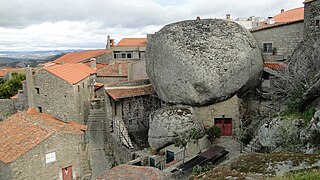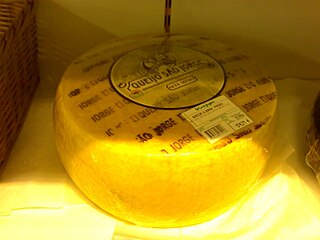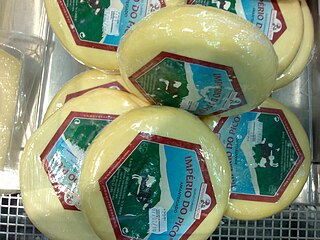
Goat cheese, goat's cheese or chèvre is cheese made from goat's milk. Goats were among the first animals to be domesticated for producing food. Goat cheese is made around the world with a variety of recipes, giving many different styles of cheeses, from fresh and soft to aged and hard.

The oldest known book on Portuguese cuisine, entitled Livro de Cozinha da Infanta D. Maria de Portugal, from the 16th century, describes many popular dishes of meat, fish, poultry and others.

The Central Region or Central Portugal is one of the statistical regions of Portugal. The cities with major administrative status inside this region are Coimbra, Aveiro, Viseu, Caldas da Rainha, Leiria, Castelo Branco, Torres Vedras, Tomar, and Guarda. It is one of the seven Regions of Portugal. It is also one of the regions of Europe, as given by the European Union for statistical and geographical purposes. Its area totals 28,462 km2 (10,989 sq mi). As of 2011, its population totalled 2,327,026 inhabitants, with a population density of 82 inhabitants per square kilometre.

Pecorino sardo is a firm cheese from the Italian island of Sardinia, made from sheep's milk, specifically from the milk of the local Sardinian breed. It was awarded denominazione d'origine status in 1991 and granted protected designation of origin protection in 1996, the year in which this European Union certification scheme was introduced.

Requeijão is a milk-derived product, produced in Portugal and Brazil. It is a loose, ricotta-like cheese used to make cheese spreads. It can be a good substitute to mild, unsalty ricotta. This variety is sometimes sold in the markets wrapped in fresh corn husks. In El Salvador, cheeses such as requesón can sometimes be transported wrapped in banana leaves instead.

Serra da Estrela cheese is a cheese made in the mountainous region of Serra da Estrela in Portugal. Under the name "Queijo Serra da Estrela" it is a Protected designation of origin (PDO) in the European Union as well as the UK.

São Jorge Cheese is a semi-hard to hard cheese, produced on the island of São Jorge, in the Portuguese archipelago of the Azores, certified as a Região Demarcada do Queijo de São Jorge and regulated as a registered Denominação de Origem Protegida.

Alcains is a Portuguese civil parish in the municipality of Castelo Branco. The population in 2021 was 4615, in an area of 36.94 km². Alcains is located within the urban agglomeration of Castelo Branco - Covilhã - Guarda, situated 12 km to the north of Castelo Branco, 230 km to the northeast of Lisbon and 280 km southeast from Oporto, while 70 km to the west of the Portuguese-Spanish border and 380 km from Madrid). It is served by the A23_motorway_(Portugal) highway, by the EN18 and EN352 national roadways, and also a rail-line from Beira Baixa Linha_da_Beira_Baixa.

Queijo de Nisa is a semi-hard sheep's milk cheese from the municipality of Nisa, in the subregion of Alto Alentejo in Portugal. It is created from raw milk, which is coagulated, then curdled using an infusion of thistle. It is yellowish white, with a robust flavor and a somewhat acidic finish.

Castelo Branco is an inland city and municipality in Central Portugal. It has 34,455 inhabitants in its urban area (2021) and is the seat of the district of the same name. The municipality, with 52,272 inhabitants, is made up of 19 freguesias spread through 1,438.19 km2 (555.29 sq mi), making it the 3rd largest in Portugal by total land area.

Cheese of Pico is a cheese originating from the island of Pico in the Portuguese archipelago of the Azores. It has been classified as a "Denomination of Protected Origin", in accordance with the laws of the European Union since October 1996.

Queijo de Cabra Transmontano is a type of cheese made from goat milk from Alto Trás-os-Montes, Norte Region, Portugal. It has a Protected designation of origin (PDO) and is listed on the Ark of Taste.

The Comunidade Intermunicipal da Beira Baixa is an administrative division in eastern Portugal. It was created in October 2013 out of the former Comunidade Intermunicipal da Beira Interior Sul, created in March 2009. Since January 2015, Beira Baixa is also a NUTS3 subregion of Centro Region, that covers the same area as the intermunicipal community. The seat of the intermunicipal community is Castelo Branco. Beira Baixa comprises a large part of the Castelo Branco District. The population in 2011 was 89,063, in an area of 4,614.64 km².

The Castle of Ródão is a medieval castle located in the civil parish of Vila Velha de Ródão, in the municipality of Vila Velha de Ródão, Portuguese Castelo Branco.














